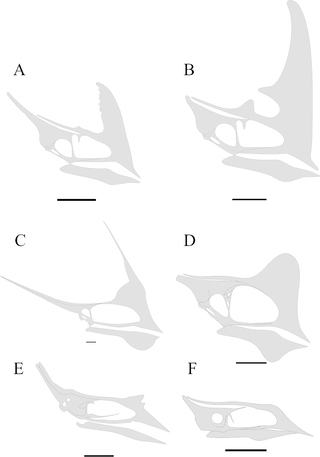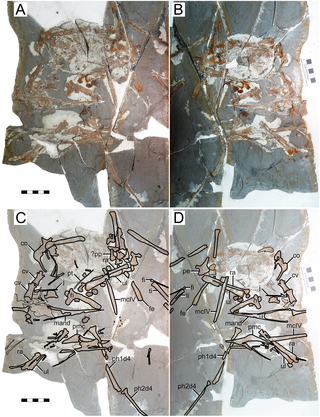
Tapejara is a genus of Brazilian pterosaur from the Cretaceous Period. Tapejara crests consisted of a semicircular crest over the snout, and a bony prong which extended back behind the head. It was a small pterosaur, with a wingspan of approximately 1.23–1.3 metres (4.0–4.3 ft).

Thalassodromeus is a genus of pterosaur that lived in what is now Brazil during the Early Cretaceous period, about a hundred million years ago. The original skull, discovered in 1983 in the Araripe Basin of northeastern Brazil, was collected in several pieces. In 2002, the skull was made the holotype specimen of Thalassodromeus sethi by palaeontologists Alexander Kellner and Diogenes de Almeida Campos. The generic name means "sea runner", and the specific name refers to the Egyptian god Seth due to its crest being supposedly reminiscent of Seth's crown. Other scholars have pointed out that the crest was instead similar to the crown of Amon. A jaw tip was assigned to T. sethi in 2005, became the basis of the new genus Banguela in 2014, and assigned back to Thalassodromeus as the species T. oberlii in 2018. Another species was described in 2015 based on a supposed crest fragment, but this was later shown to be part of a turtle shell.

Tapejaridae are a family of pterodactyloid pterosaurs from the Cretaceous period. Members are currently known from Brazil, England, Hungary, Morocco, Spain, the United States, and China. The most primitive genera were found in China, indicating that the family has an Asian origin.

Eopteranodon is a genus of tapejarid pterosaur from the Aptian-age Lower Cretaceous Yixian Formation of Beipiao City, Liaoning, China. The genus was named in 2005 by paleontologists Lü Junchang and Zhang Xingliao. The type species is Eopteranodon lii.

Chaoyangopterus is a genus of chaoyangopterid pterosaur known from a partial skeleton found in Liaoning, China. Chaoyangopterus was found in rocks dating back to the Aptian-age Lower Cretaceous Jiufotang Formation of Dapingfang, Chaoyang.
Liaoxipterus is a genus of pterodactyloid pterosaur from the Barremian-Aptian-age Lower Cretaceous Jiufotang Formation of Chaoyang, Liaoning, China. The type species is Liaoxipterus brachyognathus. The genus name is derived from the discovery locality Liaoxi and a Latinised Greek pteron, "wing". The specific name is derived from Greek brachys, "short" and gnathos, "jaw".

Jidapterus is a genus of chaoyangopterid pterosaur from the Aptian-age Lower Cretaceous Jiufotang Formation of Chaoyang, Liaoning, China. The genus was in 2003 named by Dong Zhiming, Sun Yue-Wu and Wu Shao-Yuan. The type species is Jidapterus edentus. The genus name is derived from Jílín Dàxué or "Jilin University" and a Latinized Greek pteron, "wing". The specific name means "toothless" in Latin.

Nurhachius is a genus of istiodactylid pterodactyloid pterosaur from the Barremian to Aptian-age Lower Cretaceous Jiufotang Formation of Chaoyang, Liaoning, China. Its fossil remains date back about 120 million years ago.

Liaoningopterus, sometimes misspelled as "Liaoningopteryx", was a genus of anhanguerid pterodactyloid pterosaur from the Barremian-Aptian-age Lower Cretaceous Jiufotang Formation of Chaoyang, Liaoning, China.
The Jiufotang Formation is an Early Cretaceous geological formation in Chaoyang, Liaoning which has yielded fossils of feathered dinosaurs, primitive birds, pterosaurs, and other organisms. It is a member of the Jehol group. The exact age of the Jiufotang has been debated for years, with estimates ranging from the Late Jurassic to the Early Cretaceous. New uranium-lead dates reveal the formation is deposited in the Aptian stage of the Early Cretaceous. Fossils of Microraptor and Jeholornis are from the Jiufotang.

Nemicolopterus is a dubious genus of tapejaromorph pterosaur, based on a very small specimen described as the smallest known "adult" pterosaur to date. It lived in the Jehol Biota 120 million years ago.

Shenzhoupterus is a genus of chaoyangopterid pterosaur from the Jiufotang Formation of modern-day Liaoning, China. Fossil remains of Shenzhoupterus date back to the Early Cretaceous period, approximately 120 million years ago.
Hongshanopterus is a genus of pterodactyloid pterosaur from the Lower Cretaceous Jiufotang Formation of Liaoning, China.

Chuanqilong is a monospecific genus of basal ankylosaurid dinosaur from the Liaoning Province, China that lived during the Early Cretaceous in what is now the Jiufotang Formation. The type and only species, Chuanqilong chaoyangensis, is known from a nearly complete skeleton with a skull of a juvenile individual. It was described in 2014 by Fenglu Han, Wenjie Zheng, Dongyu Hu, Xing Xu, and Paul M. Barrett. Chuanqilong shows many similarities with Liaoningosaurus and may represent a later ontogenetic stage of the taxon.

Ikrandraco is a genus of lonchodraconid pterodactyloid pterosaur known from the Lower Cretaceous Jiufotang Formation of northeastern China, and the Cambridge Greensand of England. It is notable for its unusual skull, which features a crest on the lower jaw.

This timeline of pterosaur research is a chronologically ordered list of important fossil discoveries, controversies of interpretation, and taxonomic revisions of pterosaurs, the famed flying reptiles of the Mesozoic era. Although pterosaurs went extinct millions of years before humans evolved, humans have coexisted with pterosaur fossils for millennia. Before the development of paleontology as a formal science, these remains would have been interpreted through a mythological lens. Myths about thunderbirds told by the Native Americans of the modern Western United States may have been influenced by observations of Pteranodon fossils. These thunderbirds were said to have warred with water monsters, which agrees well with the co-occurrence of Pteranodon and the ancient marine reptiles of the seaway over which it flew.

Forfexopterus is a genus of ctenochasmatid pterosaur from the Early Cretaceous Jiufotang Formation in China. It contains a single species, F. jeholensis, named from a mostly complete skeleton by Shunxing Jiang and colleagues in 2016. A second specimen, consisting of a wing, was described in 2020. While the first specimen is larger, it shows signs of being less mature than the second specimen, indicating that the developmental trajectories of Forfexopterus were variable. Like other ctenochasmatids, Forfexopterus had a long, low skull filled with many slender teeth; unlike other members of the group, however, it did not have a spatula-shaped snout tip or crests, and its teeth were more curved. A single characteristic distinguishes Forfexopterus from all other members of the wider group Archaeopterodactyloidea: of the four phalanx bones in its wing finger, the first was shorter than the second but longer than the third.
Linlongopterus is a genus of pteranodontoid pterodactyloid pterosaur from the Early Cretaceous of China. It is known from a partial skull and mandible first named and described in 2015 by Rodrigues et al.. The only known specimen was found in the Jiufotang Formation of the Liaoning Province or China, and lived around 120 million years ago. The full binomial of the taxon is Linlongopterus jennyae, with the generic name translating from the Chinese "forest" (lin) and "dragon" (long), and the Greek "wing" (pteros), while the species name honours Elfriede Kellner, nicknamed Jenny, a supporter of paleontology. The proper word for wing in ancient Greek is however pteron (πτερόν).

Huaxiadraco is a genus of tapejarid pterodactyloid pterosaur from the Aptian-age Lower Cretaceous Jiufotang Formation of Chaoyang, Liaoning, China. It is the third valid genus of tapejarid from the Jehol Biota, after Sinopterus and Eopteranodon. It contains one species, Huaxiadraco corollatus, originally assigned to the defunct genus Huaxiapterus.

































